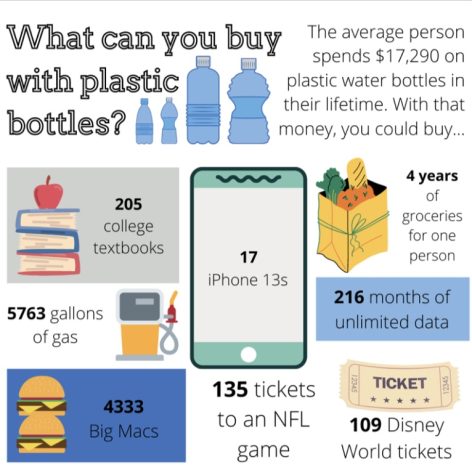10 Things You Can Do To Save the World
Our generation is key when it comes to reversing climate change. This list has 10 simple solutions for you to do your part.
Our generation is key when it comes to reversing climate change. This list has 10 simple solutions for you to do your part. (Creative Commons image)
We’ve all seen the news. The world is burning, the ice caps are melting, the turtles are dying. Climate change is expected to cause hotter temperatures worldwide, which could cause more severe weather, drought, food shortages, loss of species, human health risks, and overall poverty and displacement. The ocean is expected to rise one foot by the year 2100, which will flood coastal cities and erode thousands of miles of coastal ecosystems. But what can we do? As teenagers, we don’t have power to make laws or write policies. But in the near future we will be the ones in charge and making big impacts in the future starts with small changes now. This list has eight easy, cheap, and realistic things you can do to help reverse climate change. We as a generation need to step up and make a difference.
Go Reusable
The average person uses around 13,000 plastic water bottles in their lifetime, totaling to around $17,290 spent on plastic bottles alone. Factoring in the countless other single-use plastics used by many on a daily basis, the average American creates about 4.4 pounds of trash per day, according to the EPA. Switching to reusable resources can help keep unnecessary trash out of landfills. Many common single use plastics have a sustainable, reusable alternative. Instead of using plastic water bottles, a reusable water bottle can save resources. Other alternatives for everyday products include reusable sandwich bags, beeswax wraps, cloth bags, and reusable straws.
Recycle What Can’t be Reused
Even with all of the reusable options, some things need to be single-use. Either due to sanitary reasons or convenience, it’s unrealistic to ask that everyone use reusable everything. Recycling is the next best thing you can do to keep unnecessary waste out of landfills. According to National Geographic, in 2020, only 9% of plastics ended up being recycled. The rest ended up in landfills. This plastic takes hundreds of years to decompose, with other recyclable materials, like glass and styrofoam taking upwards of thousands of years to completely break down.
Eat Less Beef
It takes approximately 1,847 gallons of water to produce one pound of beef. (denverwater.org) Most of that water is used to grow the corn, grass, and soybeans to feed the cow, along with some water used in the processing and packaging of meat. To help conserve resources and improve your health, you can substitute beef for more efficient meats and proteins, like poultry and fish, or plant based options, like nuts and tofu. Cutting out beef completely isn’t necessary, but choosing pasture-raised or locally sourced beef products can reduce your water footprint.
Clean Your Plate
Approximately 30-40% of food in the US ends up in landfills, according to the USDA. At the consumer and retail level, billions of dollars of food are wasted each year. That means that all of the energy and water used to grow, harvest, and package the products is being wasted as well. To help keep food waste out of landfills, you can:
- Buy and cook only as much as you need
- Compost inedible scraps or leftover food
- Store and organize food properly
Power Off When You Leave
Shutting off and unplugging unnecessary appliances and devices when you leave the house is one of the easiest ways to save energy and money. By turning off one light bulb for an hour, you can save about 1.2 cents. (energy.gov) By unplugging any appliances or devices that are not being used, you can save between $100 and $200 per year. Reducing energy and electricity usage reduces the demand for fossil fuels and, in turn, decreases the amount of carbon dioxide entering the atmosphere.
Take a Walk
An average car produces about 4.6 metric tons of carbon dioxide per year. The increased burning of fossil fuels to power cars and trucks is a major contributor to the greenhouse effect that is warming the planet. According to The League of American Bicyclists, about 40% of trips are less than 2 miles in distance. Walking or biking that distance would keep unnecessary CO2 emissions out of the atmosphere and would take less than 30 minutes for the average person. Not only do you save on gas, but walking has been proven to help with mental and physical health. Taking public transportation is also a more sustainable option compared to individual passenger vehicles.

Make an Impact in Your Neighborhood
Not every change has to be monumental. Many impacts can be made right in your own neighborhood. According to The Washington Post, 300,000 tons of plastic are estimated to be littered or inadequately disposed of each year. It’s as easy as grabbing a trash bag and walking around the block. Cleaning up this litter and trash in neighborhoods and cities keeps it from polluting waterways and harming aquatic life. An estimated 8 million pieces of plastic enter the ocean every day. (ocenaconservancy.org)
Stop Fast Fashion
The fast-fashion industry is massive and almost unavoidable when it comes to online, affordable shopping. Retailers like Shein, Fashion Nova, Forever 21, Zara, and many others are all brands that use fast fashion. Clothes are quickly and cheaply made, shipped, worn, and often discarded once the trend is over. Because everything is manufactured and distributed so quickly, there is a heavy environmental impact from fast fashion. Currently, the fashion industry is responsible for more annual carbon emissions than all international flights and maritime shipping combined. Along with that, many fast fashion brands use unethical or child labor. (princeton.edu) By shopping locally, buying ethically sourced clothes, and donating to second-hand stores, the environmental impact of fast fashion brands can be reduced.
Get Involved
There are many simple ways to influence climate change laws and policies without being in a position of power. Writing to politicians, local and federal, and encouraging green policies is a way to be heard by someone with the power to make a difference. Another way that you can make an impact is by registering to vote. Voting is much more important than many people realize. Less than 70% of eligible voters ended up casting a ballot in the 2020 election, many for the reason that they were not registered. (npr.org) By voting, you can select a leader that represents your ideas and values.
Use Your Voice
Speaking up and raising awareness is one of the best ways to promote an eco-friendly and sustainable lifestyle. By posting on social media, sharing articles, and attending protests and rallies you can get your voice heard and influence others to make a change. Creating art to raise awareness is another effective way to get your voice heard. Paintings, sculptures, songs, poems; any way that you could express yourself creatively, you can use to promote solutions to climate change.
Global warming is at the forefront of world issues right now. Soon, the damage being done to our planet will be irreversible. Without immediate action, we will face detrimental consequences. By doing your part, our generation has the opportunity to reverse climate change and keep the Earth habitable for future generations.

Kaelyn is a senior at Liberty, and this is her third year on the Live Wire staff. At Liberty, she participates in NHS, garden club, SEA club, and softball....













